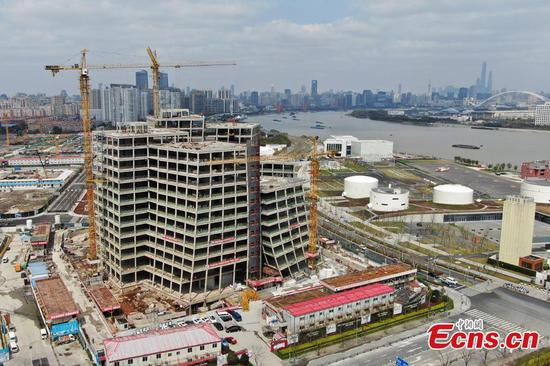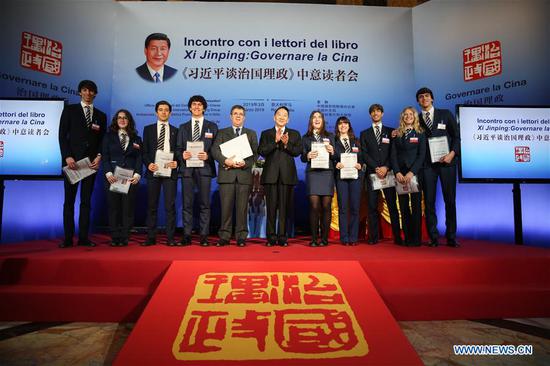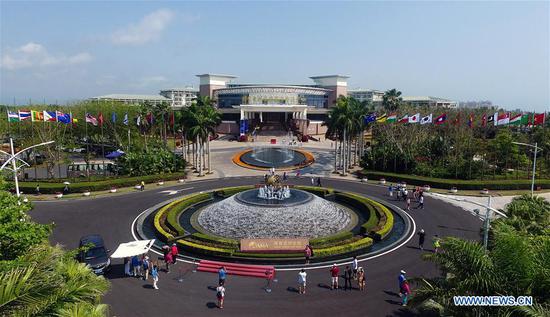
A technician works on the production line of an energy equipment manufacturer in Nantong, Jiangsu province. (XU CONGJUN/FOR CHINA DAILY)
With China's annual two sessions coming to an end, it is evident that the Chinese government is in pursuit of stable economic growth in 2019. After sustaining strong growth for more than two decades, the Chinese economy is now affected by trade disputes and the global economic slowdown. No wonder the government is calling for a cautious approach while continuing its efforts to transition the economy from an investment-driven model to one of consumption, services and innovation. These are positive steps, not just for China but also for the global economy.
While the uncertainties of the global economy are here to stay, emerging markets are expected to bring a silver lining and will remain the engine for global growth in the next decade. And as part of that, the shift of power from west to east is likely to continue. Our latest Sigma study forecasts that emerging markets will contribute 60 percent of global growth in 2028, and China alone will count for more than 25 percent.
Some may argue that emerging market growth has moderated in recent years. This is only natural as economies mature and become more exposed to external cyclical factors. In China, while the country's GDP growth target may have lowered to 6-6.5 percent, this still puts China on a fast track compared with many parts of the world.
Quality of growth becomes the differentiating factor in emerging markets
Irrespective of moderation, we still see a strong 3.5 percent, five-year-ahead growth differential between emerging and advanced markets. Thus we see an ongoing transfer of economic power from west to east. In the future, quality rather than speed of growth will be a determining factor among emerging markets themselves.
China is a primary example of this, with its current transition from a primary resource producer to being a producer in the secondary and tertiary sectors of the economy. The transition is bound to be non-linear and will inevitably carry inherent difficulties. Continuous supply-side reforms to address structural issues such as overcapacity, excess housing inventory and high leverage are therefore crucial. Also high on the Chinese government's agenda is identifying new growth engines, promoting national competitiveness through innovation, industrial upgrading and further opening-up for sustaining high-quality growth.
While the challenges facing China's economy for the next decade are substantial, the government's preferred approach of gradualism and cautious and prudent policies can alleviate the stress. We forecast China will continue to power the global economy with an annual growth rate of around five percent over the next decade.
12Next >>|
China to become the world's largest insurance market by the mid-2030s
As insurance demand has a strong positive relationship with economic growth, we forecast that emerging market premiums will more than double over the next 10 years from $1.1 trillion in 2018 to $2.9 trillion in 2028, outpacing advanced market premium growth. This is also supported by the S-curve analysis, which suggests that when GDP per capita reaches the magic number of 33,500 yuan ($5,000), insurance market growth will accelerate, reflecting the rise of an economy's middle class.
In particular, we forecast China will surpass the United States to become the world's largest insurance market by the mid-2030s. The country's GDP per capita growth has increased at a five-year CAGR of 8.2 percent, and more than a third of provinces reached above 63,740 yuan ($9,500) in 2018 – an income level associated with high income elasticity of insurance demand.
2016 S-curve, EM7 countries

Source: Insurance regulators, Swiss Re Institute
The Belt and Road Initiative (BRI) is another factor affecting the Chinese insurance market. The initiative is expected to generate a total investment of around 50 trillion yuan ($7.4 trillion), of which more than 80 percent is expected to be in infrastructure. Substantial investment will boost insurance demand. We estimate that the total premium potential from BRI-associated construction activities could reach 228 billion yuan ($34 billion) in 2015-2030, the majority of which will be booked to insurers in China. Currently the total annual premium in global engineering insurance is 140 billion yuan ($21 billion), of which only 10 billion yuan ($1.5 billion) was written in China. In addition to the direct premiums generated, there are significant opportunities for insurers to invest in BRI projects themselves.
Against these backdrops, I am very optimistic about the development of the Chinese insurance market. We forecast that premiums in China will grow three times faster than the global average over the next decade and that the country will become the biggest insurance market in 15 years.
The author is group chief economist for Swiss Re and managing editor of Sigma, responsible for economic and insurance market research. He is particularly active in external committees and roundtable discussions with policymakers in strengthening the positive dual role of the insurance sector as a long-term investor and risk absorber.
The opinions expressed here are those of the writer and do not necessarily represent the views of China Daily and China Daily website.
|<


















































